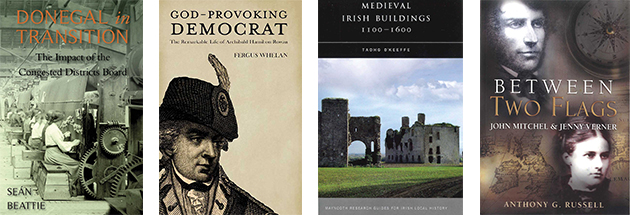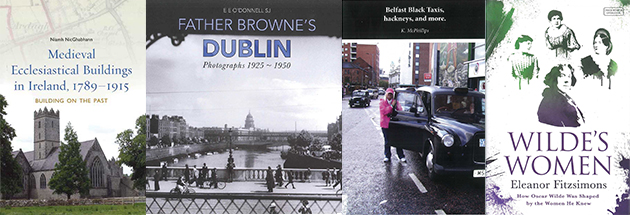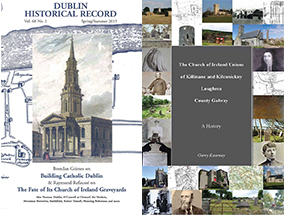BOOKWORM
Published in Book Reviews, Issue 6 (November/December 2015), Reviews, Volume 23Seán Beattie, Donegal in transition: the impact of the Congested Districts Board (Merrion Press, €21.95 pb, 298pp, ISBN 9781908928306).
Fergus Whelan, God-provoking demo-crat: the remarkable life of Archibald Hamilton Rowan (New Island, €16.99 pb, 292pp, ISBN 9781848404601).
Anthony Russell, John Mitchel and Jenny Verner: between two flags (Merrion, €19.99 pb, 267pp, ISBN 9781785370007).
Tadhg O’Keeffe, Medieval Irish buildings, 1100–1600 (Four Courts Press, €24.95 hb, 320pp, ISBN 9781846822483).
Niamh Nic Ghabhann, Medieval ecclesiastical buildings in Ireland, 1789–1915: building on the past (Four Courts Press, €55 hb, 256pp, ISBN 9781846825088).
Eleanor Fitzsimons, Wilde’s women: how Oscar Wilde was shaped by the women he knew (Gerald Duckworth & Co., £20 hb, 248pp, ISBN 9780715649367).
K. McPhilips, Belfast black taxis, hackneys, and more (Belfast, 2015, pb, 54pp).
Dublin Historical Record 68 (1), Spring/Summer 2015 (€35 annual sub., pb, 134pp, ISSN 00126861).
E.E. O’Donnell SJ, Father Browne’s Dublin photographs 1925–1950 (Messenger Publications, €14.99 pb, 96pp, ISBN 9781910248126).
Gerry Kearney, The Church of Ireland Unions of Killinane and Kilconickny, Loughrea, County Galway: a history (Kearney Books, €25 pb, 310pp, ISBN 9781910179390).

Few governmental agencies have made the impact of the Congested Districts Board (CDB) on the social and economic life of the west of Ireland. Established in 1891 by Arthur Balfour as a regional development agency, the CDB set out to raise living standards and alleviate the persistent poverty of the west. Seán Beattie’s new study, Donegal in transition: the impact of the Congested Districts Board, examines the legacy of the board in a single county. Beattie concludes that the agency made a significant impact on the county in terms of improving economic and social conditions and the promotion of self-help.
Fergus Whelan’s God-provoking democrat: the remarkable life of Archibald Hamilton Rowan explores the life of a champion of the poor and oppressed, and a founding member of the United Irishmen. Born into an Anglo-Irish landowning class, Rowan (1751–1832) survived several duels, exile and numerous ill-fated affairs with married women, all the while plotting to overthrow the state and establish a republic in Ireland. He endured eleven years of hardship on both sides of the Atlantic before managing to return to Ireland in 1806.
Anthony Russell’s John Mitchel and Jenny Verner: between two flags examines the lives and relationship of Young Irelander John Mitchel and his loyal wife, Jenny Verner. Destined to be separated by death in different continents, the couple’s relationship withstood revolutionary upheaval, separation, exile and, ultimately, heartbreak. Arrested for treason and sentenced to fourteen years in Tasmania, Mitchel escaped in 1853 and was given a hero’s welcome in San Francisco. The couple’s children’s untimely deaths, their support of slavery and their experience of the American Civil War are examined in detail.
Medieval Ireland continues to be well documented in Irish historiography, and by Four Courts Press in particular. Tadhg O’Keeffe’s Medieval Irish buildings, 1100–1600 has just been published as part of the Maynooth Research Guides for Irish Local History. This volume is the eighteenth in the series and consists of an astounding chronicling of the architectural legacy of the medieval world, from early ecclesiastical buildings to the Anglo-Normans and the plantations. The volume includes hundreds of images, drawings, plates and figures and represents a remarkable contribution to the period.
Taking the baton from Tadhg O’Keeffe, Niamh Nic Ghabhann’s Medieval ecclesiastical buildings in Ireland, 1789–1915: building on the past is the first full-length study of the perception and treatment of Gothic architecture in the period between 1789 and 1915. It considers three main areas: the perception of Gothic architecture; the development of the tradition of scholarship on the topic; and the social and legal framework for changes wrought to the fabric of these buildings.

As editor of Woman’s World (1887–9), Oscar Wilde commissioned articles by leading progressive female writers and ensured that the magazine examined ‘not merely what women wear, but with what they think, and what they feel’. Eleanor Fitzsimons’s Wilde’s women: how Oscar Wilde was shaped by the women he knew is a comprehensive account of the leading women in Wilde’s life, including his mother, Lady ‘Speranza’ Jane Wilde, and his wife Constance, an active member of a number of feminist groups.
A rich tapestry of local studies continues to be handsomely produced, ensuring a vibrant local historical publishing scene. The people of Belfast have become so accustomed to the presence of black taxis on their streets that it has become easy to overlook the wider significance of the trade. Belfast black taxis, hackneys, and more by K. McPhilips provides an overview of the evolution of the taxi trade, its social significance and political origins. It is based on interviews with people employed in the trade and examines its unique and troubled history.
The Dublin Historical Record is now in its 68th volume, and the Spring/Summer 2015 edition includes nine valuable essays on various aspects of the history of ‘Strumpet City’, including Brendan Grimes on the patrons and architects of Catholic churches in the nineteenth century, Seán Magee on the Sweetman breweries in the eighteenth century and Raymond Refaussé on the Church of Ireland graveyards of the nineteenth century.

E.E. O’Donnell’s Father Browne’s Dublin photographs 1925–1950 is the latest edition of the Browne collection to be published and is a treasury of outstanding images of the capital. Fr Francis Browne is best known for his pictures taken on board the ill-fated Titanic, and he was later gassed on five occasions while serving as a chaplain on the Western Front. His collection of photographs consists of 35,000 images, of which 4,500 were taken in Dublin. These 100 or so images focus on the lives of ordinary working people and the poor and represent an outstanding contribution to the social history of Dublin.
Gerry Kearney’s The Church of Ireland Unions of Killinane and Kilconickny, Loughrea, County Galway: a history will be of great interest to genealogists and researchers of eccl-esiastical history. The book includes a chronological list and history of the bishops of Clonfert and Kilmacduagh from 1400 to the present; lists of clergy from the parishes; transcripts and extracts of parish and vestry records; and graveyard inscriptions.
















